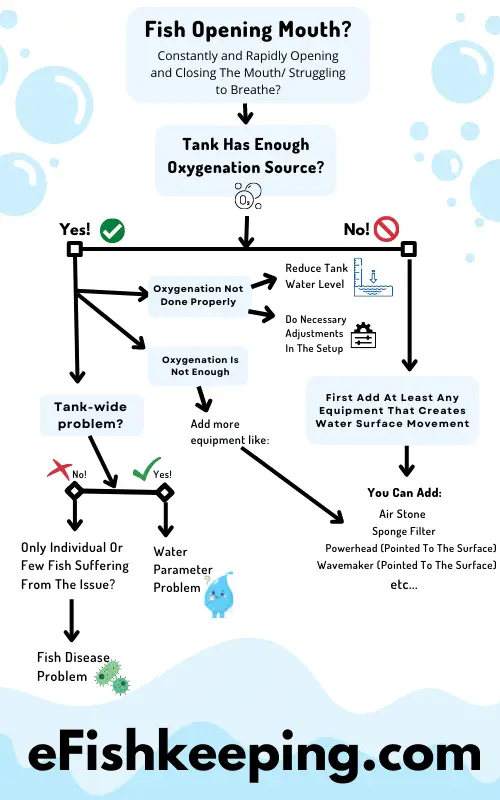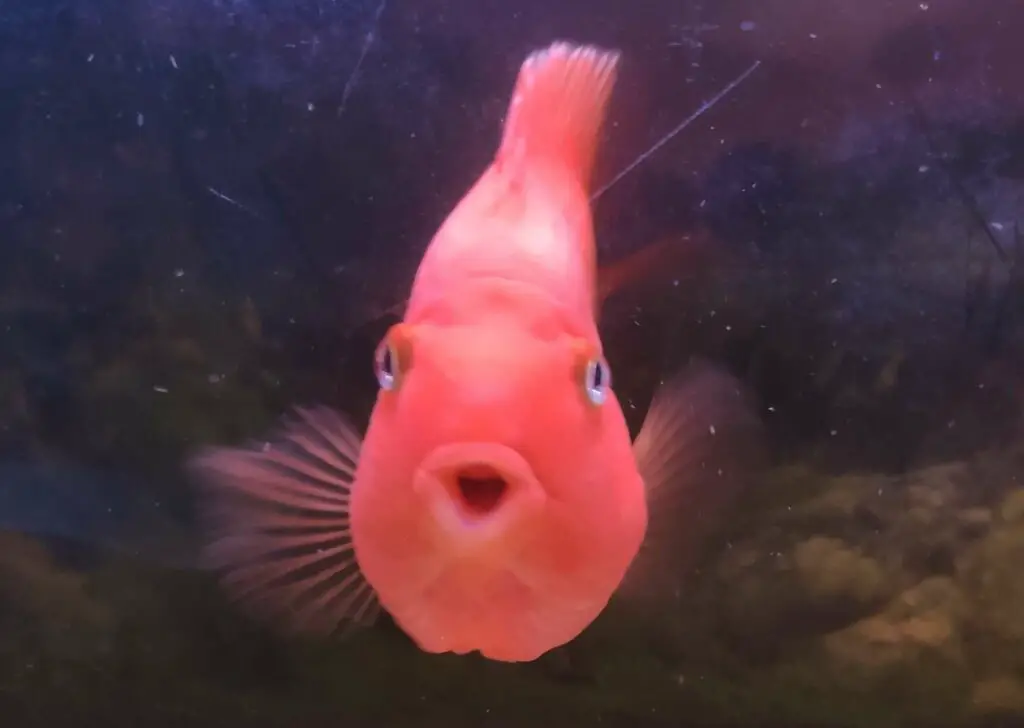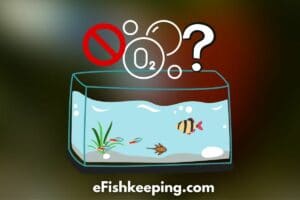The most common reason a fish is opening its mouth and constantly working it is the lack of enough oxygen in the tank. Adding an air stone or pointing the filter to create water surface agitation and lowering the tank’s temperature can solve the problem.
Having said that, sometimes, problems can be a bit more complicated than a simple oxygenation issue. Read on to find out more!
Quick Troubleshooting Guide For Fish Constantly Opening Mouth
In case you are in a hurry, here’s a quick troubleshooting guide for you.

Check:
- Is any equipment in the tank that creates water movement at the surface (surface agitation)?
The equipment can be anything like an air stone, a powerhead or wavemaker pointed towards the top, a filter creating bubbles that pop at the top, or some waterfall.
- If you don’t have any equipment, get one first because it’s the first and most important thing.
- And if you already have one, then likely the surface agitation is either not enough or not done adequately.
Generally, if your tank is full up to the brim, the water surface agitation may not be occurring correctly. So try to reduce the water level in the tank and see if enough water movement is happening now.
You can wait for some time and check if the fish starts acting normal or not after you apply the tip. You can also make other necessary adjustments in the equipment set up to enhance water movement at the surface.
If the problem persists after trying all these, you will have to add more air stones, filters, or gears like powerheads and wavemakers.
The current oxygenation may not be enough depending on the number of fish in your tank. Hence, you will have to add more oxygenation sources to the tank.
Applied all the troubleshooting tips, but still, the issue remains? Then that means:
Lack of oxygenating equipment like air stones in the tank – Checked!Not having Enough oxygenating equipment (adding extra equipment if needed) – Checked!Oxygenation in the tank is not enough – Checked!
If the problem continues, we have already ruled out all the possibilities related/contributing to the lack of enough oxygen in the tank.
- So now check whether the fish opening mouth problem is only related to a single fish, or is it a tank-wide problem?
- If the problem is tank-wide and all your fish are constantly opening and closing mouths, the problem is likely related to poor water parameters.
- However, if the problem is only related to a single fish, it is most likely because of an underlying disease.
So this was just a quick overview and troubleshooting. To get better help and understand everything in detail, continue reading till the end.
How Do Fish Breathe? A Brief Overview
Fish are aquatic organisms, and generally, they breathe by absorbing dissolved oxygen in the water using their gills.
Fish intake water into the mouth. The water is then passed through the gills located just behind the head of the fish on each side. Then, the dissolved oxygen is absorbed, whereas carbon dioxide is released into the water, finally dispelled out!
Gills contain a lot of small blood vessels that help in maximizing oxygen extraction. So that’s how fish breathe oxygen.
I highly recommend you to watch this video to understand the respiration in fish visually:
Now, the question is if fish take water from their mouths which then passes through the gills. Does that mean they need to work their mouths constantly? Do they need to open and close their mouths continuously?
Is Fish Opening Mouth Normal?
No! Fish opening their mouth or rapidly opening and closing is not normal. Generally, in a fish tank, the mouth of the fish is supposed to remain calm and not rapidly opening and closing.
I have three fish tanks at our home and have been keeping fish since childhood. From experience, I can tell you that fish constantly opening a mouth is not normal.
So if you notice your fish opens its mouth, there’s likely something problematic going on in your tank. And in most cases, lack of adequate oxygenation in the tank is the main culprit behind the issue.
Generally, the bubbles the filters and air stones produce help oxygenate the tank. But that doesn’t occur the way we normally think.
Air Pumps and air stones don’t act like oxygen tanks! The bubbles made by the air stones (often also called bubblers) are not directly oxygenating the tank.
The thing that helps is the surface agitation – the break up of surface tension at the water surface.
The bubbles rise from the bottom, creating the water movement at the top.
The surface agitation (surface water movement) facilitates the gaseous exchange because of which the rate of oxygen entering the tank and CO2 leaving out the tank water increases.
So when fish are continuously struggling to breathe, opening and closing their mouth rapid, here’s what to do:
Why Do Fish Open Their Mouth? Reasons & Solutions!

#1. Lack Of Adequate Oxygenation In The Tank
When there isn’t appropriate oxygenation in the tank, the fish start gasping.
They struggle to breathe, and you see them rapidly opening and closing their mouths.
The oxygenation in the tank can be less due to different reasons:
Not Having Surface Agitating Equipment:
If you have a fish tank in which no equipment like air stone, filter, or powerhead is running, there is likely no water movement at the surface.
Due to a lack of surface agitation or water movement, the oxygenation might not be happening correctly.
Having An Overcrowded Tank:
Oxygenation issues can arise when there’s a lot of fish stuffed in a fish tank. So even though you have some air stone running, that may not be enough.
The rate at which the fish consume oxygen could exceed the rate at which the tank is replenished with fresh oxygen. It is this time when the fish will start struggling for enough oxygen and show rapid mouth movements.
Read: How Long Fish Can Live Without Oxygen, Air Pump, & Filter?
High Temperature In Tank
There is an inverse relationship between dissolved oxygen and temperature. When temperature increases, the dissolved oxygen level in the water tends to decrease.
So, if the water temperature is too high, that could be why fish are struggling to get oxygen.
Solution:
First, identify the main reason why your tank has low oxygenation. Then apply the solutions accordingly.
- If the problem is a lack of enough air stones or other oxygenating equipment, get more of them.
- If you have an overcrowded tank, try to reduce the number of fish in the tank. Although this cannot be practical in situations, if possible, you can do so. Maybe having a spare tank can be helpful during these times.
- And if the problem is related to temperature, reduce the water temperature of your heater. But, be careful not to decrease the temperature too much. Research the temperature requirement of your fish. And gradually move towards the lower end of the temperature only within limits suitable for the fish.
You can also add ice cubes to cool down the water temperature. Just while adding, place them in an airtight bag to prevent them from melting in the fish tank water.
#2. Inadequate Water Parameters
Ammonia and Nitrite present in water can affect the gills of your fish and lead them to gasp.
The waste from fish, plants, and all foods in your fish tank ecosystem ultimately breaks down and releases ammonia. Now, this ammonia can be very toxic for fish.
A higher concentration of ammonia in water can make it harder for the fish to discard ammonia from their body. This ammonia build-up can further lead to gill and internal organ damage, stress, and even death.
The presence of ammonia in water causes the fish to produce excess mucus. This, in turn, decreases the gill’s surface area and thereby decreases its efficacy in extracting oxygen.
Likewise, not only ammonia but the nitrite levels can also affect the respiration of fish. Turns out, Nitrite can alter the hemoglobin bit that carries oxygen and affects the blood. As a result, the fish tend to gasp while they try extracting oxygen from the water.
Ideally, the safe level of ammonia is 0 ppm. And same goes with the nitrite level, which should be 0 ppm!
Long story short, any signs of ammonia or nitrite should concern you.
Solution:
Here’s what you need to do whenever you notice a spike in ammonia or nitrite levels in your fish tank water:
Perform water change:
Your tank is either filled with excess nitrite or ammonia (or maybe both). So in such a case, the first thing you can do is perform a water change. As a general rule, you can do around 30-50% of water change.
By doing a water change, you are discarding the fish water filled with ammonia or nitrite with fresh water. Hence, this solution can be helpful.
However, be careful! Avoid sudden large water change because it can drastically shift the water parameters. And your fish may not be able to tolerate that, and it can even die.
Use Water Conditioners:
In times of emergency ammonia or nitrite spike, having a quick and go-to solution is a great relief, isn’t it? And that’s why I highly recommend you to have a bottle of water conditioner like Seachem Prime.
It is a water conditioner and probably one of the best out there. It can not only remove chlorine and chloramine from water but also helps in detoxifying ammonia, nitrite, and nitrates. And it works for both fresh and saltwater.
But do note that Seachem Prime remains bound to compounds like ammonia, nitrite, and nitrate for only up to 48 hours. However, if you feel the ammonia and nitrite levels are increasing within a 24-hour period, you can re-dose Seachem Prime every 48 hours.
I have written a detailed post on Seachem Prime. I highly encourage you to have a look at it if you want to learn more.
#3. Fish Suffering From Disease
Different diseases that affect the fish’s gills can also cause breathing problems. For example, viral diseases such as Koi Herpes Virus and Carp Edema Virus.
These viruses primarily target the gills of the fish and can cause your fish to become lethargic or die suddenly, along with signs of struggling to breathe.
Moreover, parasites that replicate within the gills of fish (for instance, white spot) can also lead to gill damage and make the fish struggle to breathe. You may also observe other signs like decreased appetite, flashing.
Solution:
First, check whether the rapid opening and closing mouth is related to only one fish or is it a widespread problem.
If the problem is only related to one or few fish, then the problem is not with water parameters nor oxygenation. Instead, the problem is likely with any disease that has affected the gills.
So in such a case, you need to look for symptoms in your fish. And then check for a cure of the disease accordingly.
Read More: Can Fish Survive Ich (White Spot Disease) Without Treatment?
How To Prevent Fish From Opening Mouth Constantly?
The best way to prevent fish from opening their mouth constantly is to prevent all the root causes of the issue. Here’s how you can prevent the problem:
- Always have an adequate filtration system in your tank that takes care of all the waste clean-up.
- Check if the tank has enough oxygenation and if the fish look normal. If needed, add extra air stones or other equipment to oxygenate the tank better.
- Don’t forget to do regular water changes as you usually do.
Here’s a general recommendation you can follow:
| Tank Stocking Level: | Water Change: |
| Light | Bi-Weekly 20% |
| Average | Weekly 15-20% |
| Heavy | Weekly 20-30% |
- Ensure that the water parameters remain as stable as possible, which you can check using a test kit.
- Try to quarantine your fish in a separate quarantine tank system. Quarantining prevents the spread of disease to other healthy fish in your tank. Usually, most hobbyists quarantine their fish for at least 2-4 weeks.
Final Thoughts
In short, if your fish are constantly opening and closing their mouth, it is a sign they are struggling to breathe. The most common reason is not having enough oxygenation in the tank. However, there can be other reasons like the affected gill due to bad water parameters or diseases.
Usually, adding more air stones, creating a waterfall effect at the surface to generate water movement, or adding other equipment that causes enough water movement solves the issue.
That’s it! I hope this guide has helped you to know the root cause and fix the problem. If you found this post helpful, please consider sharing it with others. Thanks, and I hope your fish becomes fit and fine soon!
Related Read: Why Do Fish Yawn?
Hi! I’m Praveen Ghoshal, the founder of eFishkeeping.com. Inspired by my Dad, I got interested in fishkeeping when I was a kid. Since then, I have been involved with this hobby. Currently, I have 3 fish tanks at our home, and I enjoy this hobby with my full family. Read more about me here.







